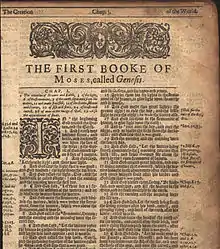| Genesis 1:1 | |
|---|---|
1:2 → | |
 The first chapter of Genesis (B'reshit in Hebrew) written on an egg in the Israel Museum | |
| Book | Book of Genesis |
| Hebrew Bible part | Torah |
| Order in the Hebrew part | 1 |
| Christian Bible part | Old Testament |
| Order in the Christian part | 1 |
Genesis 1:1 is the first verse of the first chapter of the Book of Genesis in the Hebrew and Christian Bibles and the opening of the Genesis creation narrative.
Text
The Hebrew is as follows:
- Vocalized: בְּרֵאשִׁית בָּרָא אֱלֹהִים אֵת הַשָּׁמַיִם וְאֵת הָאָרֶץ
- Transliterated: Bereshit bara Elohim et hashamayim ve'et ha'aretz.
- Bereshit (בְּרֵאשִׁית): "In [the] beginning [of something]". Be is a prepositional prefix, reshit is a noun, "beginning". The definite article ha (i.e., the Hebrew equivalent of "the") before reshit is missing, but implied.[1]
- bara (בָּרָא): "[he] created/creating". The word is in the masculine singular form, so that "he" is implied; a peculiarity of this verb is that it used only of God.[2]
- Elohim (אֱלֹהִים): the generic word for God, whether the God of Israel or the gods of other nations; it is used throughout Genesis 1, and contrasts with the phrase YHWH Elohim, "God YHWH", introduced in Genesis 2.
- et (אֵת): a particle used in front of the direct object of a verb, in this case "the heavens" and "the earth", indicating that these are what is being "created".
- Hashamayim ve'et ha'aretz (הַשָּׁמַיִם וְאֵת הָאָרֶץ): "the heavens and the earth"; this is a merism, a figure of speech indicating the two stand not for "heaven" and "earth" individually but "everything"; the entire cosmos.[3]

The Opening of Genesis Chapter 1 from a 1620–21 King James Bible in black letter type. The first edition of the KJV was 1611.
It can be translated into English in at least three ways:
- As a statement that the cosmos had an absolute beginning ("In the beginning, God created the heavens and earth").
- As a statement describing the world's condition when God began creating ("When in the beginning God created the heavens and the earth, the earth was untamed and shapeless").
- Taking all of Genesis 1:2 as background information ("When in the beginning God created the heavens and the earth, the earth being untamed and shapeless, God said, Let there be light!").[4]
Analysis
Genesis 1:1 forms the basis for the Judeo-Christian doctrine of creation out of nothing (creatio ex nihilo) and some scholars still support this reading,[5] but most scholars agree that on strictly linguistic and exegetical grounds, this is not the preferred option,[6][7][8] and that the authors of Genesis 1, writing around 500–400 BCE, were concerned not with the origins of matter (the material which God formed into the habitable cosmos), but with the fixing of destinies.[2]
See also
- Genesis 1:2
- Parashat Bereshit
- Apollo 8 Genesis reading while in lunar orbit, December 24, 1968
References
Citations
- ↑ Blenkinsopp 2011, pp. 30–31.
- 1 2 Walton 2006, p. 183.
- ↑ Waltke 2011, p. 179.
- ↑ Bandstra 1999, pp. 38–39.
- ↑ Day 2021, p. 3.
- ↑ Blenkinsopp 2011, p. 30.
- ↑ Nebe 2002, p. 119.
- ↑ Clifford 2017, p. unpaginated.
Bibliography
- Bandstra, Barry L. (1999). Reading the Old Testament: An Introduction to the Hebrew Bible. Wadsworth Publishing Company. ISBN 0495391050.
- Blenkinsopp, Joseph (2011). Creation, Un-Creation, Re-Creation: A Discursive Commentary on Genesis 1–11. T&T Clarke International. ISBN 9780567372871.
- Clifford, Richard J (2017). "Creatio ex Nihilo in the Old Testament/Hebrew Bible". In Anderson, Gary A.; Bockmuehl, Markus (eds.). Creation ex nihilo: Origins, Development, Contemporary Challenges. University of Notre Dame. ISBN 9780268102562.
- Day, John (2021). From Creation to Abraham: Further Studies in Genesis 1-11. Bloomsbury Publishing. ISBN 978-0-567-70311-8.
- Nebe, Gottfried (2002). "Creation in Paul's Theology". In Hoffman, Yair [in Hebrew]; Reventlow, Henning Graf (eds.). Creation in Jewish and Christian Tradition. Sheffield Academic Press. ISBN 9780567573933.
- Waltke, Bruce K. (2011). An Old Testament Theology. Zondervan. ISBN 9780310863328.
- Walton, John H. (2006). Ancient Near Eastern Thought and the Old Testament: Introducing the Conceptual World of the Hebrew Bible. Baker Academic. ISBN 0-8010-2750-0.
This article is issued from Wikipedia. The text is licensed under Creative Commons - Attribution - Sharealike. Additional terms may apply for the media files.